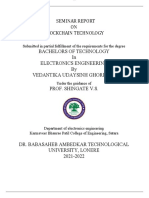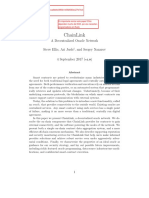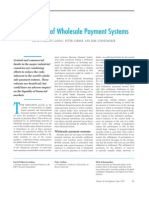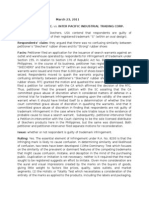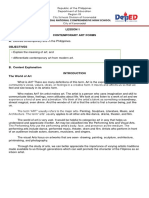Notes on Blockchain Technology
Blockchain is a decentralized, distributed digital ledger technology that securely
records transactions across many computers in such a way that the registered
transactions cannot be altered retroactively. Blockchain's key feature is its
ability to ensure transparency, security, and decentralization, making it highly
useful in many industries beyond just cryptocurrencies.
1. Introduction to Blockchain
What is Blockchain?
A blockchain is a continuous chain of records, called blocks, which are linked
together using cryptographic hashes. Each block contains:
A list of transactions.
A timestamp.
A reference (hash) to the previous block in the chain.
The primary function of blockchain is to store and manage data in a way that
eliminates the need for intermediaries (such as banks) and ensures data integrity,
transparency, and trust.
Key Characteristics of Blockchain:
Decentralization: There is no central authority. The data is maintained across
a network of computers (nodes).
Immutability: Once data is added to the blockchain, it cannot be altered or
deleted without altering all subsequent blocks, which makes it highly resistant to
fraud.
Transparency: All transactions are publicly recorded and can be accessed by
anyone on the blockchain network.
Security: Transactions are secured using cryptography, ensuring data integrity
and confidentiality.
2. How Blockchain Works
a. Transaction Process:
Initiation: A user initiates a transaction (e.g., sending cryptocurrency).
Broadcasting: The transaction is broadcast to a network of computers (nodes) on
the blockchain.
Validation: Nodes validate the transaction using predefined rules, ensuring it
is legitimate.
Block Creation: Once validated, the transaction is grouped with others in a
block.
Consensus Mechanism: The new block is added to the chain after reaching
consensus via protocols like Proof of Work (PoW) or Proof of Stake (PoS).
Finalization: The block is added to the blockchain, and the transaction becomes
permanent.
b. Key Elements:
� Block: The unit of storage that holds transaction data.
Hash: A cryptographic fingerprint that identifies each block and ensures data
integrity.
Public/Private Key: Used in blockchain transactions for security and identity
verification.
Node: Any device or computer connected to the blockchain network.
3. Blockchain Types
a. Public Blockchain:
Definition: A fully decentralized and open blockchain where anyone can
participate as a node and validate transactions.
Examples: Bitcoin, Ethereum.
Advantages:
Completely decentralized.
Transparent and permissionless.
Open to anyone for participation.
Disadvantages:
Slower transaction speeds.
High energy consumption (e.g., Bitcoin's Proof of Work).
b. Private Blockchain:
Definition: A permissioned blockchain where only specific entities are allowed
to validate transactions.
Examples: Hyperledger, Corda.
Advantages:
Faster transactions due to fewer participants.
Better scalability.
Disadvantages:
Less decentralized.
Requires trust in the central authority.
c. Consortium Blockchain:
Definition: A blockchain where multiple organizations collaborate to validate
transactions, creating a semi-decentralized system.
Examples: R3 Corda, Energy Web Foundation.
Advantages:
� Balances decentralization and efficiency.
Trusted by multiple parties.
Disadvantages:
Still not as decentralized as public blockchains.
d. Hybrid Blockchain:
Definition: A combination of both public and private blockchains, allowing for
controlled access and some degree of transparency.
Examples: Dragonchain, IBM Blockchain.
Advantages:
Flexibility and scalability.
Customizable levels of privacy and security.
Disadvantages:
Complex to manage and implement.
4. Consensus Mechanisms
Consensus mechanisms are protocols that blockchain networks use to agree on the
validity of transactions and to ensure data consistency across decentralized
networks.
a. Proof of Work (PoW):
Definition: In PoW, participants (miners) compete to solve complex mathematical
puzzles to validate transactions and add a new block to the blockchain.
Examples: Bitcoin, Ethereum (before Ethereum 2.0).
Advantages:
Secure and highly decentralized.
Disadvantages:
High energy consumption.
Slow transaction speed.
b. Proof of Stake (PoS):
Definition: In PoS, participants (validators) are selected to create new blocks
based on the amount of cryptocurrency they hold and are willing to "stake" as
collateral.
Examples: Ethereum 2.0, Cardano, Polkadot.
Advantages:
Energy-efficient.
� Faster than PoW.
Disadvantages:
Can lead to centralization if wealthy participants dominate the network.
c. Delegated Proof of Stake (DPoS):
Definition: A variation of PoS where stakeholders vote for a few delegates who
are responsible for validating transactions and adding blocks.
Examples: EOS, TRON.
Advantages:
Faster block creation and validation.
Increased scalability.
Disadvantages:
Can be more centralized.
d. Proof of Authority (PoA):
Definition: Validators are pre-approved by a central authority, and the
identity of the validator is used as the main form of security.
Examples: VeChain, Kovan (testnet for Ethereum).
Advantages:
High throughput and fast transactions.
Disadvantages:
Less decentralized.
5. Applications of Blockchain Technology
a. Cryptocurrencies
Blockchain is the foundational technology for cryptocurrencies such as Bitcoin,
Ethereum, and Litecoin.
Use Case: Enabling decentralized, peer-to-peer digital currency without relying
on banks or governments.
b. Supply Chain Management
Blockchain helps track goods from production to delivery, ensuring transparency
and reducing fraud.
Example: IBM Food Trust tracks food products' journey from farm to table,
improving safety and traceability.
c. Smart Contracts
Smart contracts are self-executing contracts where the terms are directly
�written into code.
Use Case: Automating agreements and transactions without the need for
intermediaries.
Example: Ethereum's smart contract functionality allows for the creation of
decentralized applications (dApps).
d. Voting Systems
Blockchain can create secure, transparent, and tamper-proof voting systems for
elections.
Use Case: Ensuring election integrity by preventing vote manipulation or fraud.
Example: Voatz has been used in US elections for secure, blockchain-based
voting.
e. Healthcare
Blockchain can help store and share medical records securely across different
healthcare providers, improving patient care and privacy.
Use Case: A blockchain network can ensure secure and accurate sharing of
patient health data between doctors, hospitals, and insurance providers.
f. Digital Identity
Blockchain technology can help create secure digital identities that
individuals control, preventing fraud and improving privacy.
Example: SelfKey provides decentralized digital identity solutions.
6. Advantages of Blockchain
Security: Transactions are cryptographically secured, making blockchain highly
resistant to fraud and hacking.
Transparency: Public blockchains are transparent, enabling any participant to
verify the data.
Decentralization: Eliminates the need for intermediaries, reducing costs and
increasing trust.
Immutability: Once a transaction is recorded, it cannot be changed or erased,
ensuring data integrity.
Efficiency: Blockchain can streamline processes, reduce administrative
overhead, and increase the speed of transactions.
7. Challenges of Blockchain
a. Scalability
As more users join a blockchain network, the time and cost associated with
processing transactions can increase, limiting its scalability. Solutions like
sharding and Layer 2 scaling are being explored to address this issue.
b. Energy Consumption
� Blockchain networks like Bitcoin, which use Proof of Work, consume enormous
amounts of energy due to the computational power required for mining.
c. Regulatory and Legal Issues
Many countries are still developing legal frameworks for blockchain and
cryptocurrencies, and regulations vary widely. Issues related to compliance,
taxation, and anti-money laundering are significant hurdles for mainstream
adoption.
d. Adoption and Integration
Integrating blockchain with existing systems can be complex, and there are
still many barriers to its wide-scale adoption in industries like finance,
healthcare, and government.
8. Future of Blockchain
Blockchain technology is rapidly evolving and expanding beyond cryptocurrencies
into sectors such as healthcare, supply chain, voting, and intellectual property.
Key developments include:
Quantum-resistant cryptography: To prepare for the potential future threat
posed by quantum computers.
Interoperability: Creating solutions that allow different blockchain systems to
communicate with each other.
Integration with AI: Blockchain’s decentralized and secure nature makes it a
great match for AI, which could use blockchain for training data transparency,
privacy, and model accountability.
Conclusion
Blockchain technology is poised to revolutionize industries by providing secure,
transparent, and efficient ways to store and manage data. Its applications go far
beyond cryptocurrencies and are already disrupting sectors like supply chain
management, healthcare, and voting systems. While challenges like scalability,
energy consumption, and legal issues remain, the potential of blockchain technology
in creating decentralized solutions is vast.
























